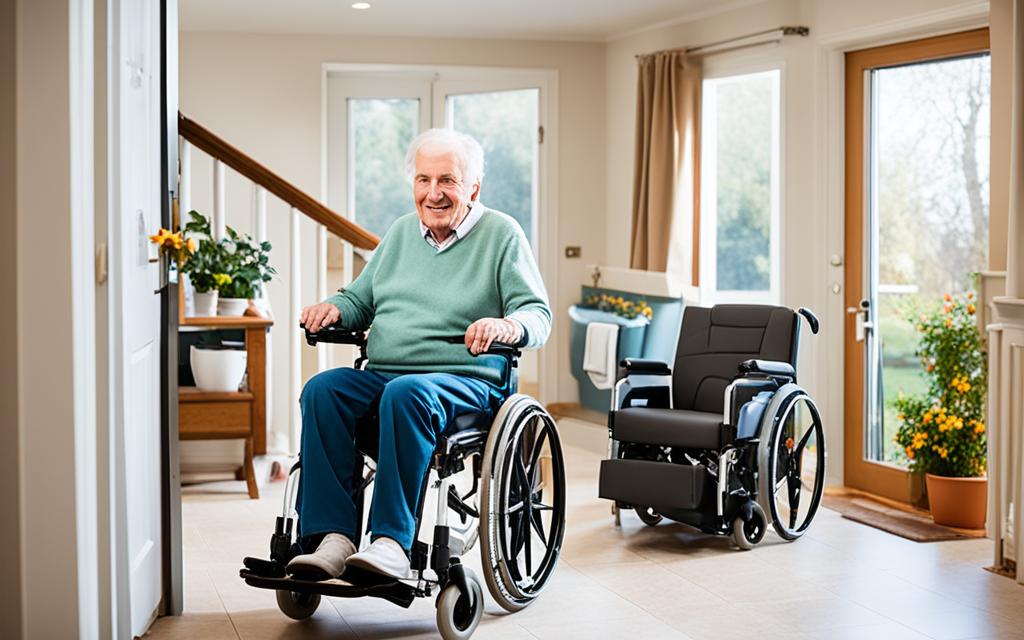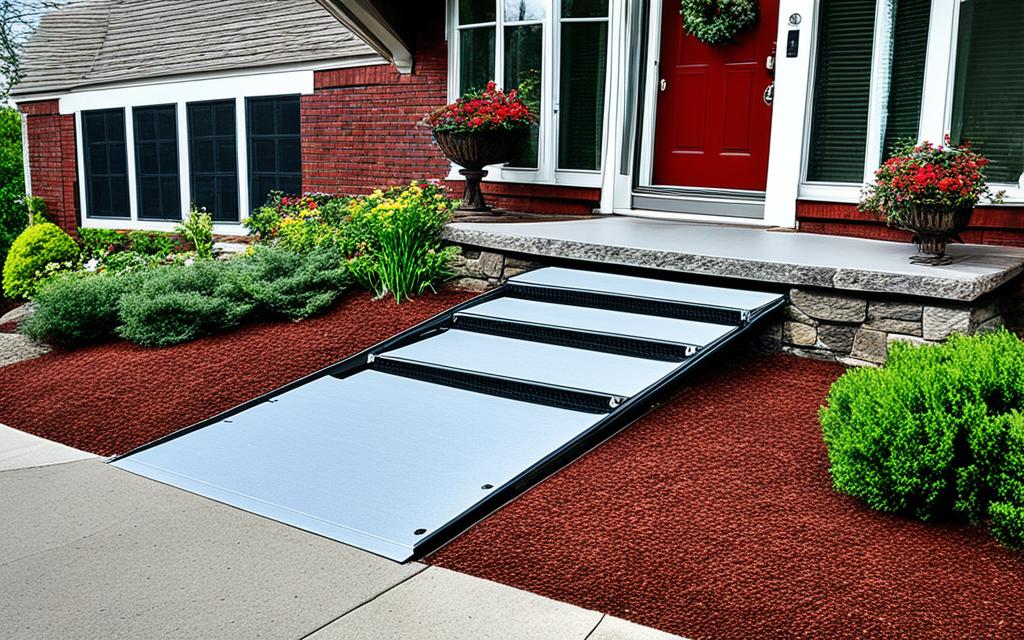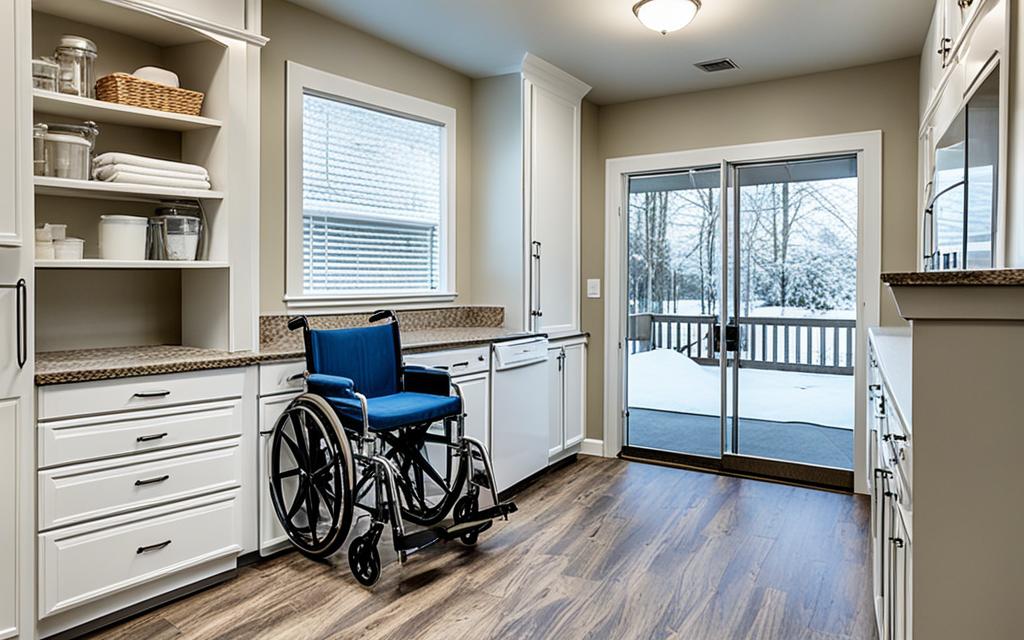Did you know nearly half of Aussies over 65 with a disability have installed handrails in their homes? It’s more than a number. It shows we’re moving towards a world where accessible home mods are key. Today, making homes suitable for all, through disability housing adaptations and aged care home renovations, is crucial.
Key Takeaways
- A significant proportion of elderly and disabled Australians have made crucial modifications to their homes, indicating a substantial demand for Types Of Home Modifications For The Disabled & Elderly In Australia.
- Modifications such as ramps and grab rails have proved crucial in enabling independence and preventing falls, pointing to the importance of accessible home mods.
- Home adaptations are significantly improving the living conditions of individuals with various disabilities, showcasing the necessity for inclusive disability housing adaptations.
- Investing in home adaptations is not only about safety—it’s about enabling our elderly loved ones to continue to live in comfort, reinforcing the need for thoughtful aged care home renovations.
- Organisations across Victoria offer support and assistance, ensuring that the necessary modifications are available to those in need, through various programs tailored to enhance accessibility in homes.
Understanding the Importance of Home Accessibility Modifications
In Australia, more people are getting older, which makes home accessibility modifications crucial. As folks age, they need homes that support living on their own with ease. Getting services that help make these changes is critical for many people, not just a nice-to-have.
The Growing Need for Age-Friendly Living Environments
The Commonwealth Home Support Programme (CHSP) is key in making homes better for the elderly. It aims to let older adults live on their own with little help. Adding a few accessibility features can greatly help them maintain this independence.
Improving Quality of Life Through Adaptive Home Design
Adaptive home design is about making homes safe and respectful. Adding ramps and making doorways wider helps everyone live better at home, no matter their mobility. The CHSP works to provide these changes and more, like personal care and nursing, to meet different needs.
- The CHSP helps elderly Australians stay in their homes, with 1,400 providers, mostly not-for-profit, supporting accessible living solutions.
- In 2020-2021, people’s contributions were just 10% of the CHSP’s funding, showing strong government backing.
- The program offers everything from house help to adaptive home design work, focusing on improving life quality for users.
The support and modifications made at home are vital. They help the elderly and disabled live with respect and empowerment. This highlights how valuable the CHSP is in Australia’s effort to care for its people.
Types Of Home Modifications For The Disabled & Elderly In Australia
In Australia, more elderly folks and people with disabilities need disability-friendly home upgrades. These changes help them move freely and live more independently in their homes. The healthcare system and government in Australia have created guides and support for senior-friendly home modifications.
Lifts and stairlifts are key mobility aids for home use outlined in the RAP Schedule AL05 and AL07. Options include Stair Chairs, Wheelchair Platform Lifts, Inclinators, Stair Climbers, or Vertical Platform Lifts. These help those who find stairs tough, making it easier and safer to get around multi-level homes.

For more complex home modifications, the DVA has clear rules on what changes are covered. This may involve adding platform steps, making showers easier to get into, or installing ramps. These bigger changes need careful planning and a waiting period after surgery before starting.
It’s essential that complex home modifications are planned with healthcare professionals. They aim to meet urgent needs in the main home, helping improve day-to-day life. – Occupational Therapist, Home Accessibility Department
An Occupational Therapist must approve each modification after assessing needs at home. Stringent rules apply, especially for Vertical Platform Lifts, which are for those with service-related injuries or approved disabilities.
- Complex home modifications need approval and detailed paperwork.
- These changes must fit the client’s health needs, not just future wants.
- Paperwork should include plans, signed off specs, and photos of the needed changes.
These disability-friendly home upgrades and senior-friendly home modifications are essential, not just extra comforts. They are crucial for Australians with mobility issues to lead safer, more independent lives in their own homes. Making sure homes have the right mobility aids is a big step toward this goal.
Creating Safe Bathrooms with Disability-Friendly Upgrades
Bathroom safety is essential for people with disabilities or older individuals. Disability housing adaptations are crucial in this. They help make homes in Australia accessible, focusing on bathroom modifications for the elderly. This isn’t just for ease; it’s about promoting respect and self-reliance.
Essential Bathroom Adaptations for Independent Living
Some key changes are needed to help with independent living. Installing walk-in showers and shower seats makes bathrooms safer and easier to use. The Victorian Aids and Equipment Program helps by providing these adaptations at a lower cost. It ensures that those who need aid get it, even if they’re not covered by NDIS.
Adaptive Solutions for a Safe and Comfortable Bathing Experience
The Land and Housing Corporation sets guidelines to keep adaptation costs reasonable. Adding safety features like grab bars and non-slip floors is crucial. The goal is safety and making sure these improvements last.
It’s important to request modifications through trusted groups like SWEP or Yooralla. An Assistive Technology prescriber will assess what’s needed. The right equipment, from shower seats to walk-in showers, helps individuals feel confident and independent every day.
Home Care Packages vary in support levels but even small changes can greatly lessen fall risks in the bathroom. LAHC’s rules help clarify what adjustments are possible, helping residents improve their living spaces for safety and flexibility.
Mobility Enhancements with Ramps, Rails, and Lift Solutions
Australia shows its care for the elderly and disabled through helpful subsidies. Programs like My Aged Care and the National Disability Insurance Scheme (NDIS) make important home changes possible. Such support turns dreams of easier living into reality.
Having ramps for wheelchair access at home is crucial. They make getting in and around the house easy. These improvements are key for Australians wanting to stay part of their community. They help avoid the loneliness that comes when it’s hard to move around.
Ease of Access with Installation of Ramps and Lifts
It’s important for homes to have safe entryways. Ramps work well because they fit different mobility aids. Adding stair lifts makes homes with stairs friendly for everyone. This shows how valuable being independent is.

Handrails and Stairlifts: Safeguarding Mobility Across Your Home
Ramps and stair lifts tackle big barriers in homes. But, it’s also key to think about smaller changes like handrails. Placed well, they help people move safely at home.
The National Disability Insurance Scheme (NDIS) and My Aged Care see the worth in these small fixes. ConnectAbility’s support shows this too. It’s about living better and more independently.
In conclusion, changes like stair lifts and ramps make homes more welcoming. They change living areas into safe spaces. This reflects Australia’s advanced stance on disability and aged care. It gives those in need a better life at home.
Senior-Friendly Modifications for Effortless Navigation
Creating a home that meets the needs of seniors is essential for their independence and life quality. Making changes in their homes helps with everyday tasks, making them safer and easier. These modifications help Australia’s elderly enjoy their homes more.
Door and Handle Modifications for Easier Movement
Choosing lever handles over round knobs makes a big difference. They are easier to use for people with arthritis or hand issues. This change is a part of making homes easier to navigate.
Adding automatic sliding doors improves a home for seniors. These doors don’t need effort to open, lowering the risk of strain. They blend well with the home’s look and are handy.
Strategic Lighting and Furnishing Adjustments to Prevent Falls
Good lighting and smart furniture layout help prevent falls. Using LED and motion-sensor lights means well-lit areas that save energy. With smart home devices, lights can be controlled easily, even by voice.
Making a home safe for seniors means removing things that can cause trips. Reviewing furniture placement and getting rid of clutter are important steps. It’s about creating spaces that are safe and easy to move around in.
These changes in the home show we value the independence and health of older Australians. They make homes safer and more enjoyable.
Choosing the Right Flooring for Enhanced Stability
In making an adaptive home design, picking the right flooring is key for stability and safety. Falls are the main cause of injuries, so choosing slip-resistant flooring is vital. Vinyl or non-slip tiles are great because they reduce risks and help everyone feel more secure.
It’s also critical to keep your home free of clutter. Things like loose cords and extra furniture can get in the way and cause trips. Cleaning up and placing non-slip mats in places like the bathroom and kitchen helps create a safer space.
Slip-Resistant Flooring Options to Minimize Hazards
Studies reveal that homes last longer when they’re designed to be adaptive from the start. Slip-resistant floors are essential not just for now, but for the future. This saves money by cutting down on the need to make changes later. Also, homes can be recognized as adaptable, making them more attractive on the market.
Clearing Clutter and Cords for Unhindered Access
Getting rid of mess and cords boosts safety and meets Australian Standards AS4299-1995 and AS 1428.1-2009. Talking about this early on with architects and builders sets the stage for a liveable and adaptable home. It makes the home flexible for any changes needed down the road.
Design flexibility from thinking ahead lets homes change as needed, making them last longer. With the rise of shared housing in Australia, there’s a growing acceptance of making spaces that support both economic stability and community connection.
Leveraging Technology for Accessible Living Solutions
In Australia, there’s a big push to help people with disabilities and the elderly live more independently. This is thanks to assistive technology. These tech changes are making a huge difference. They help make homes user-friendly for those who wish to live on their own.
Automation and Smart Home Devices to Support Independence
At the forefront are smart homes. They come equipped with home automation systems. These systems control lights, heat, and security with just voice commands or simple interfaces. Automation also includes entertainment and communication devices. This makes technology easier to access for users.
Personal Alert Systems and Home Care Package Integration
Medical alert systems can save lives by connecting users to emergency help. This is very important for those living alone. By wearing these devices, they can easily call for help. Adding these systems to home care packages means people feel safer. Both users and their families can relax more.
These technologies blend into daily life and home care packages well. This helps people really feel independent. Programs like My Aged Care are key. They ensure these tech solutions are available. This shows how modern tech can truly change care and support. It’s a big step towards making living easier for everyone in Australia.
Support and Funding for Accessibility Projects in Australia
Changing a home can be tough, especially when you think about the cost. But in Australia, there is help and money available to make it easier for people with disabilities or for older people. The Commonwealth Home Support Programme gives basic help. It includes making important home changes to help people live independently. This is the first step to getting more help. It ensures Australians can stay safe and keep their pride at home.
Australians can also get more help through home care packages from My Aged Care. These packages provide a lot of support, designed for the complicated needs of people as they get older. These changes at home help people live safer and more freely. It doesn’t let the way a house is set up stop them from doing things. Also, people under 65 can get help from NDIS funding. This gives them money to make their homes easier to live in, suiting their own special needs.
Groups like ConnectAbility and Your Side are here to help Australians make their homes better places to live. They offer special services, like giving advice and overseeing projects that make homes more accessible and comfortable. For those looking to improve their living situation, help is easy to find. This support makes a big difference for older Australians and those with disabilities.
FAQ
Q: What types of home modifications are there for the disabled and elderly in Australia?
A: Modifications for homes include grab bars, ramps, and stair lifts. Widened doorways, lever handles, and automatic doors are added too. Walk-in showers with seats, smart devices, and alert systems make homes better for the disabled and elderly.
Q: Why is there a growing need for age-friendly living environments?
A: As Australia’s population ages, we need homes that fit the elderly’s needs. This helps them stay independent and safe in their own homes longer.
Q: How can adaptive home design improve the quality of life for the elderly?
A: Adaptive designs make homes safer and easier to use. This reduces falls and boosts independence. It makes life better for the elderly.
Q: Which bathroom modifications can help in making bathrooms safe for the elderly and disabled?
A: For safer bathrooms, install grab bars and walk-in showers. Add shower seats, raised toilets, non-slip mats, and hand-held showerheads. These changes help the elderly and disabled use bathrooms by themselves safely.
Q: How do ramps and lifts improve wheelchair accessibility in homes?
A: Ramps make moving in and out smoother. Lifts help move between floors easily. These changes make homes more wheelchair-friendly without big construction.
Q: What modifications can be made to doors and lighting to ensure effortless navigation for seniors?
A: Use lever handles instead of knobs and opt for automatic doors. Add motion-sensor lights for better visibility. These changes prevent falls and make moving around the house easier for seniors.
Q: Why is flooring choice important in accessible home design?
A: Choosing floors like vinyl or tiles prevents slips. A clear floor space, free of clutter and wires, is safer and more accessible.
Q: How does technology aid in creating accessible living solutions?
A: Home automation and smart devices let people control their homes by voice or remote. Alert systems offer a quick way to get help in emergencies. Together, they support independent living at home.
Q: What support and funding are available for home accessibility projects in Australia?
A: Programs like the Commonwealth Home Support Programme and NDIS help. My Aged Care offers home care packages. They provide money for home changes that make living safer and more independent for the disabled and elderly.
Source Links
- People with Disability in Australia – Housing Related Needs
- Victorian Aids and Equipment Program
- Commonwealth Home Support Programme (CHSP)
- Rehabilitation Appliances Program (RAP) – Complex Home Modifications
- Home Modification Guidelines
- Home Modifications for the Elderly
- Scoping Review on Best Practice for Home Mods Service Delivery
- Liveable Adaptable Home

